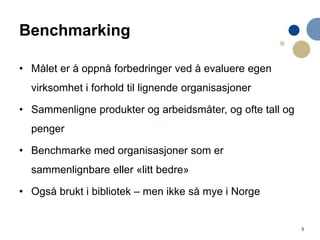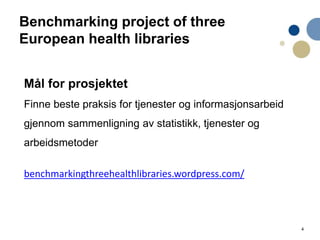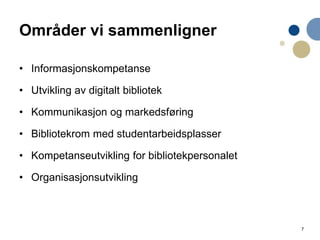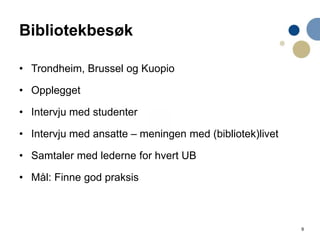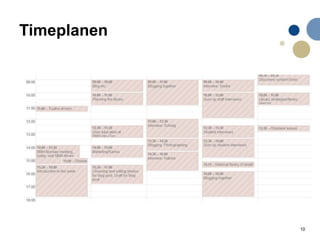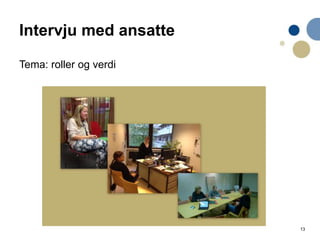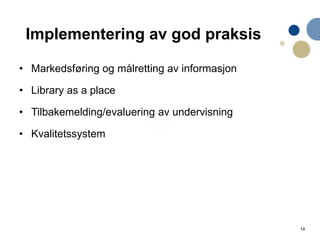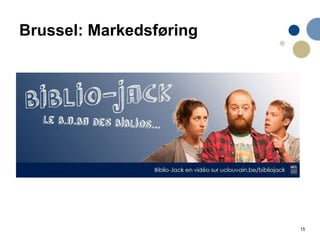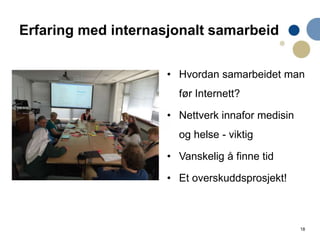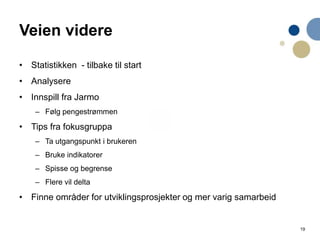Benchmarking og bibliotekutvikling
- 1. Benchmarking og bibliotekutvikling UH-bibliotekkonferansen 2015 Karen Johanne Buset, NTNU UB
- 2. 2 ŌĆó Benchmarking som metode ŌĆó Benchmarking project of three European health libraries ŌĆó Hva har vi sammenlignet - og hva har vi funnet ut ŌĆó Erfaringer ŌĆō og fordeler - med internasjonalt samarbeid ŌĆó Veien videre for prosjektet
- 3. 3 Benchmarking ŌĆó M├źlet er ├ź oppn├ź forbedringer ved ├ź evaluere egen virksomhet i forhold til lignende organisasjoner ŌĆó Sammenligne produkter og arbeidsm├źter, og ofte tall og penger ŌĆó Benchmarke med organisasjoner som er sammenlignbare eller ┬½litt bedre┬╗ ŌĆó Ogs├ź brukt i bibliotek ŌĆō men ikke s├ź mye i Norge
- 4. 4 Benchmarking project of three European health libraries M├źl for prosjektet Finne beste praksis for tjenester og informasjonsarbeid gjennom sammenligning av statistikk, tjenester og arbeidsmetoder benchmarkingthreehealthlibraries.wordpress.com/
- 5. 5 Benchmarking project of three European health libraries Partnere: ŌĆó Universit├® Catholique de Louvain, Brussel ŌĆó University of Eastern Finland, Kuopio University Hospital Medical Library ŌĆó NTNU Universitetsbiblioteket, Bibliotek for medisin og helse
- 6. 6 Tidslinje ŌĆó Februar 2013 ŌĆō Oppstart, planleggingsfase ŌĆó V├źr 2013 ŌĆō h├Ėst 2014 ŌĆō Innsamling og sammenligning av statistikk og bakgrunnsinformasjon Online m├Ėter ŌĆó November ŌĆō Desember 2014 ŌĆō Bibliotekbes├Ėk ŌĆó N├ź: bearbeiding av funn
- 7. 7 Omr├źder vi sammenligner ŌĆó Informasjonskompetanse ŌĆó Utvikling av digitalt bibliotek ŌĆó Kommunikasjon og markedsf├Ėring ŌĆó Bibliotekrom med studentarbeidsplasser ŌĆó Kompetanseutvikling for bibliotekpersonalet ŌĆó Organisasjonsutvikling
- 8. 8 Statistikk
- 9. 9 Bibliotekbes├Ėk ŌĆó Trondheim, Brussel og Kuopio ŌĆó Opplegget ŌĆó Intervju med studenter ŌĆó Intervju med ansatte ŌĆō meningen med (bibliotek)livet ŌĆó Samtaler med lederne for hvert UB ŌĆó M├źl: Finne god praksis
- 10. 10 Timeplanen
- 11. 11 Intervju med studenter ŌĆó 6-8 ulike omr├źder i biblioteket ŌĆó Stunt-intervju med enkeltpersoner eller grupper som satt/arbeidet i omr├źdene ŌĆó Sp├Ėrsm├źl: ŌĆō Hva bruker du biblioteket til? ŌĆō Hvorfor sitter/arbeider du akkurat her? ŌĆō Hvor ville du jobbe hvis biblioteket ikke fantes?
- 12. 12 Hva l├”rte vi ?
- 13. 13 Intervju med ansatte Tema: roller og verdi
- 14. 14 Implementering av god praksis ŌĆó Markedsf├Ėring og m├źlretting av informasjon ŌĆó Library as a place ŌĆó Tilbakemelding/evaluering av undervisning ŌĆó Kvalitetssystem
- 16. 16 Trondheim: Biblioteket som sted
- 17. 17 Kuopio: Organisering og evaluering av undervisning
- 18. 18 Erfaring med internasjonalt samarbeid ŌĆó Hvordan samarbeidet man f├Ėr Internett? ŌĆó Nettverk innafor medisin og helse - viktig ŌĆó Vanskelig ├ź finne tid ŌĆó Et overskuddsprosjekt!
- 19. 19 Veien videre ŌĆó Statistikken - tilbake til start ŌĆó Analysere ŌĆó Innspill fra Jarmo ŌĆō F├Ėlg pengestr├Ėmmen ŌĆó Tips fra fokusgruppa ŌĆō Ta utgangspunkt i brukeren ŌĆō Bruke indikatorer ŌĆō Spisse og begrense ŌĆō Flere vil delta ŌĆó Finne omr├źder for utviklingsprosjekter og mer varig samarbeid
Editor's Notes
- #19: Finne partnere Verkt├Ėy og arbeidsformer EAHIL workshop ŌĆō fokusgruppe MEN! Tidsproblematikk



